Computer storage has come a long way since our last roundup. We have new PCIe 4.0 SSDs, NVMe drives are becoming the de facto standard for new machines, and prices for legacy drives have plummeted. Rather than just focusing on high-end drives, this time we decided to take a step back and explore the entire storage market from top to bottom.
For someone piecing together their next build, the choices can be overwhelming. Do you go with the latest and greatest SSDs, a mid-tier value offering, or a dirt cheap SATA drive? There are also many different market segments between these areas making it hard to tell if spending a few extra dollars will get you much extra performance. Finally, how has the performance of mechanical hard drives stood up in the world of SSDs? We'll answer all of these today, so let's dive in.
On the table below you'll see all the drives we have today and we'll briefly go on why they were selected. This review isn't so much to show which drive in a particular category is best, but rather, to show how different types and tiers of drives stack up in common applications.
| Drive | Capacity (As Tested) |
Max Read (MB/s) |
Max Write (MB/s) |
Category | Price | $/GB |
| Corsair MP600 | 1TB | 4950 | 4250 | NVMe Gen 4.0 | $185 | $0.185 |
| Intel Optane 900P | 280GB | 2500 | 2000 | NVMe Gen 3.0 | $370 | $1.32 |
| Samsung 970 Pro | 1TB | 3500 | 2700 | NVMe Gen 3.0 | $300 | $0.30 |
| Samsung 970 Evo Plus | 1TB | 3500 | 3300 | NVMe Gen 3.0 | $200 | $0.20 |
| Samsung 860 Evo | 500GB | 550 | 520 | SATA M.2 | $95 | $0.19 |
| Crucial MX500 | 1TB | 560 | 510 | SATA | $108 | $0.108 |
| Seagate Ironwolf | 8TB | 210 | 210 | SATA (7200 RPM) | $220 | $0.027 |
| WD Red | 4TB | 150 | 150 | SATA (5400 RPM) | $117 | $0.029 |
| Seagate Firecuda | 2TB | 156 | 140 | SATA (5400 RPM) | $100 | $0.05 |
Starting at the bottom, we have three traditional mechanical HDDs. They are big both physically and in terms of internal storage capacity. They are cheap, compatible with nearly every system, and have been in use for decades. Most HDDs come in either 7200 RPM or 5400 RPM models (10K RPM models are also available, but rarer) with the former being more expensive but faster.
The WD Red and Seagate Firecuda drives are 5400 RPM drives, while the Seagate Ironwolf is a larger 7200 RPM drive. Comparing the WD Red and Seagate Ironwolf, the 7200 RPM model costs less per GB, but that's just because we have a drive that is larger. For equal sized drives, the 7200 RPM models will almost always be slightly more expensive.
The third mechanical drive, the Seagate Firecuda, is a hybrid drive. It uses a small amount of internal solid state storage to try to offer some of the performance improvements of SSDs while remaining near the price of HDDs. Commonly used files can be read from or written to the cache first which increases throughput and decreases latency. However, once the cache is full or if the file you want isn't in the cache, you'll end up going back to the slower magnetic storage.
The rest of the drives tested are all SSDs from varying technology standards and price points. We have the Crucial MX500 which represents a commodity SATA SSD. It remains one of the best selling SSDs on the market since it is very affordable and offers significantly better performance than a traditional mechanical hard drive.
Next, we have the Samsung 860 Evo. This is another SATA drive, but this time switches to the increasingly popular M.2 form factor. This drive is positioned slightly above the MX500, but also features technology that is a few years old.
Above that, we have the Samsung 970 Evo Plus and 970 Pro, representing one of the most popular and well regarded NVMe SSDs on the market. Like other drives with the Evo name, the 860 Evo and 970 Evo Plus use 3-bit MLC NAND vs 2-bit NAND on their respective "Pro" cousins. Part of that tradeoff is endurance. Evo drives also contain a buffer cache to speed up writes to small files, which generally works well making a wide majority of consumer-level workloads as fast as with Pro drives.
The two most advanced drives in today's test are the Intel Optane 900p and Corsair MP600. Optane aims to bring together the fast response time of RAM and the large capacity of SSDs. It is by far the most expensive consumer storage technology on the market. Optane is typically best for very specific enterprise applications since its raw read and write speeds are significantly slower than other drives that cost a fraction of the price. The Corsair drive is a top of the line SSD using the latest PCIe 4.0 standard. Check out our full comparison between Gen 4.0 and Gen 3.0 drives if you'd like a deeper dive into that area. The MP600 wasn't the fastest drive from our roundup, but instead serves as a representative for the performance level those drives have.
The jump from spinning hard drives to solid state storage was immense, and if you were to compare the first couple of generations of SSDs to today's fastest options, you would see a huge jump as well. Most recently, moving away from SATA to NVMe allowed for much more bandwidth, but that doesn't always translate into real world performance you can perceive. To explain this, we need to understand that storage isn't the only thing your computer is waiting on while it performs a task.
Some applications may be storage limited and others may be compute limited. A storage limited application is one that uses a lot of data, but doesn't do much heavy processing on that data. For example, copying a file isn't very computationally intensive so a faster drive will almost always result in a faster completion time.
On the other hand, compute limited applications use very little data, but perform large amounts of computations on it. Some games and most productivity applications are compute bound. That means that once you get past a certain point, a faster storage device won't translate into faster completion.
Now, lets start looking at some benchmarks. A few synthetic tests have been run to get a general feel for how fast the rated speeds for these drives are, but then we'll turn to all real world measurements. All test results shown are an average of at least 3 runs.
Benchmarks
The standard sequential read and write tests clearly show the performance different between generations. The mechanical drives sit at roughly 100MB/s, the SATA SSDs are at roughly 500MB/s, the PCIe 3.0 drives are around 3000MB/s, and the PCIe 4.0 drive is at 5000MB/s for read speeds.
Even though the 970 Evo Plus is $100 cheaper than the 970 Pro, it outperforms the Pro in this limited write test due to the high-speed write cache used. If the test used larger files that filled up the buffer, its write performance would have dropped in half.
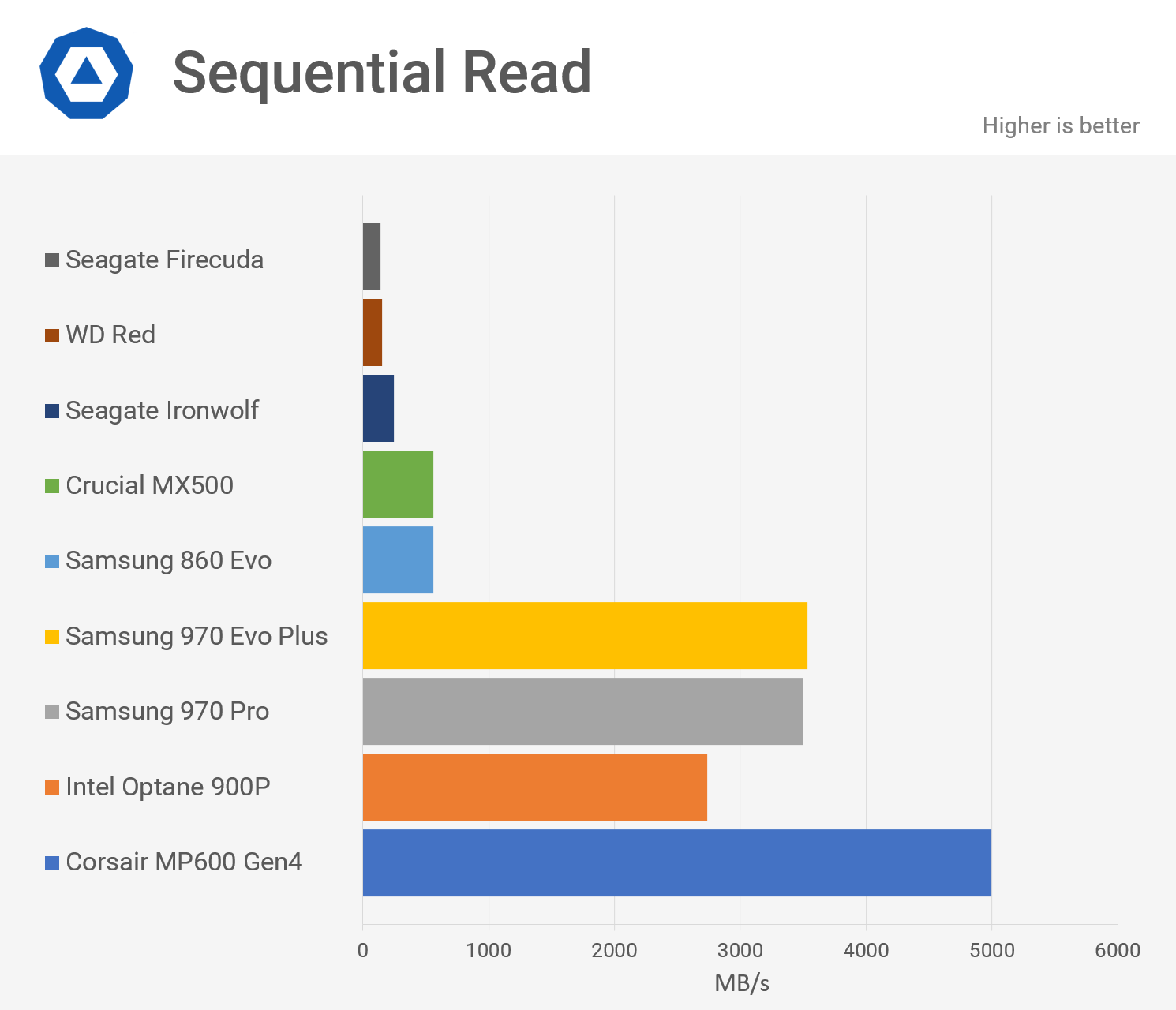
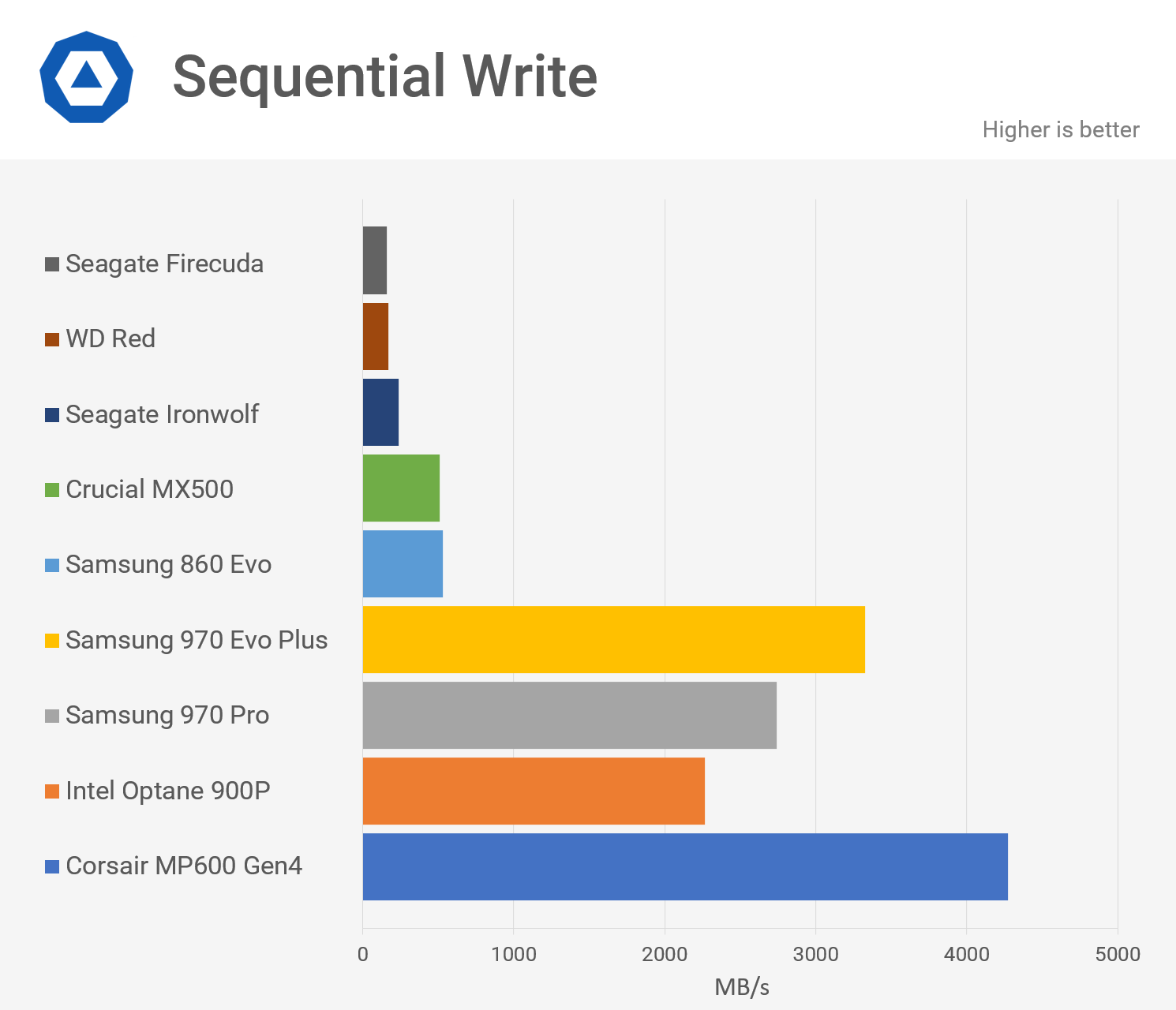
Moving on to random reads and writes, the mechanical drives almost don't even register on the scale. For a mechanical drive to perform a random access, it has to wait for the spinning platter to physically rotate around to the read head. All an SSD has to do is query a specific bit since there are no moving parts to wait for.
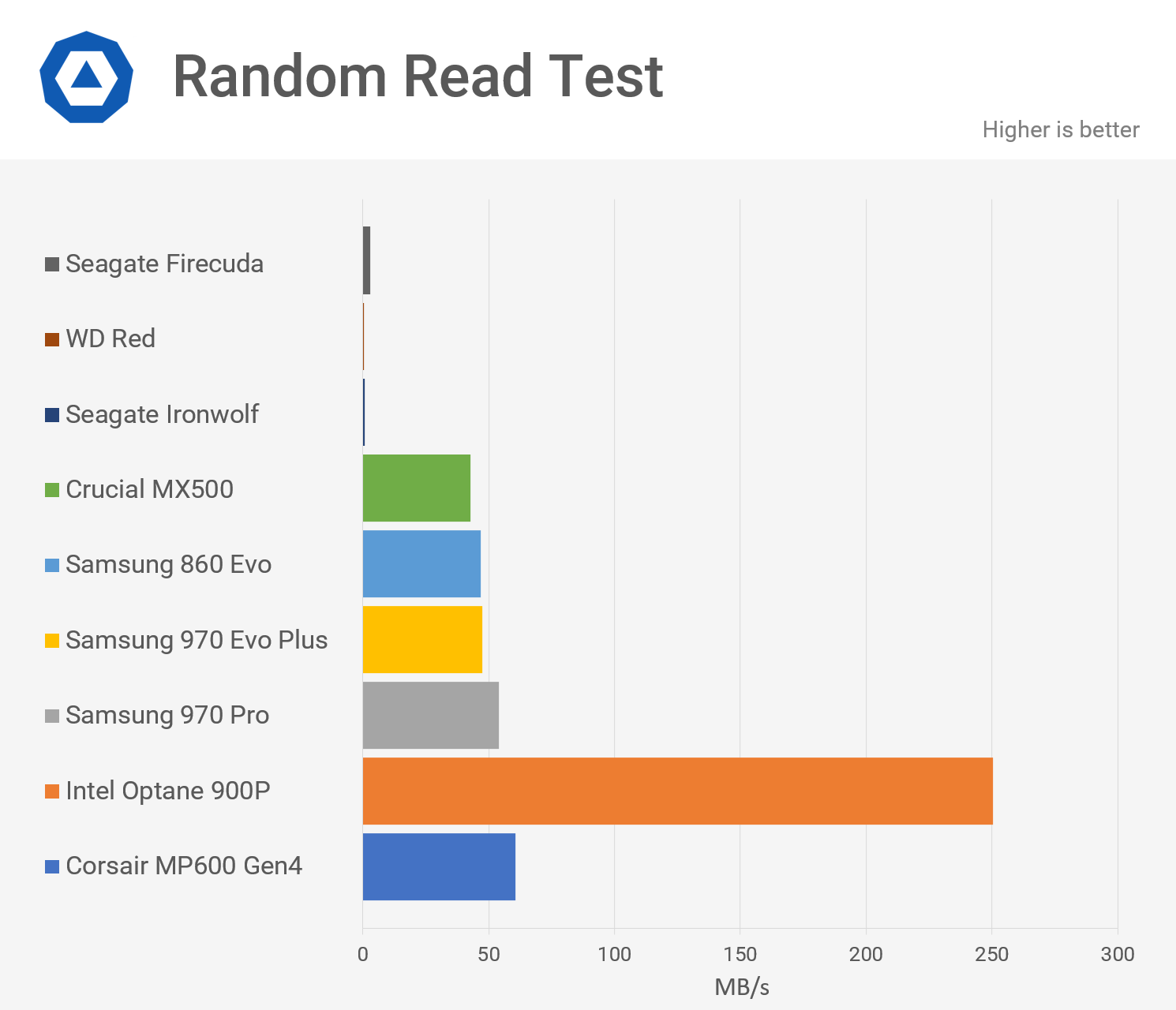
As expected, the Optane drive is the clear winner here due to its low access latency when querying random files. The MX500, the cheapest of the SSDs, is also the slowest of the solid state drives. We see that the three Samsung SSDs perform close to each other, though the SATA interface is vastly slower than PCIe. Since this test doesn't reach the bandwidth limit of SATA, adding a faster interface doesn't really help us.

Random access is one test where paying more for the same type of drive will typically get you better performance. It's very easy for manufacturers to deliver fast sequential speeds, but random reads are far more difficult. This is where larger R&D budgets can help create more advanced algorithms.

Next up we have three application storage traces which were generated using PCMark 8. Although the results come from a benchmarking application, they are still very much real world tests. They are essentially just replaying a copy of the read and write requests made by various applications and timing how long that takes. In all three test sets, the SSDs perform nearly identically while the HDDs lag considerably behind. This is again caused by the majority of the applications becoming compute bound once a drive that is faster than 200MB/s is used.
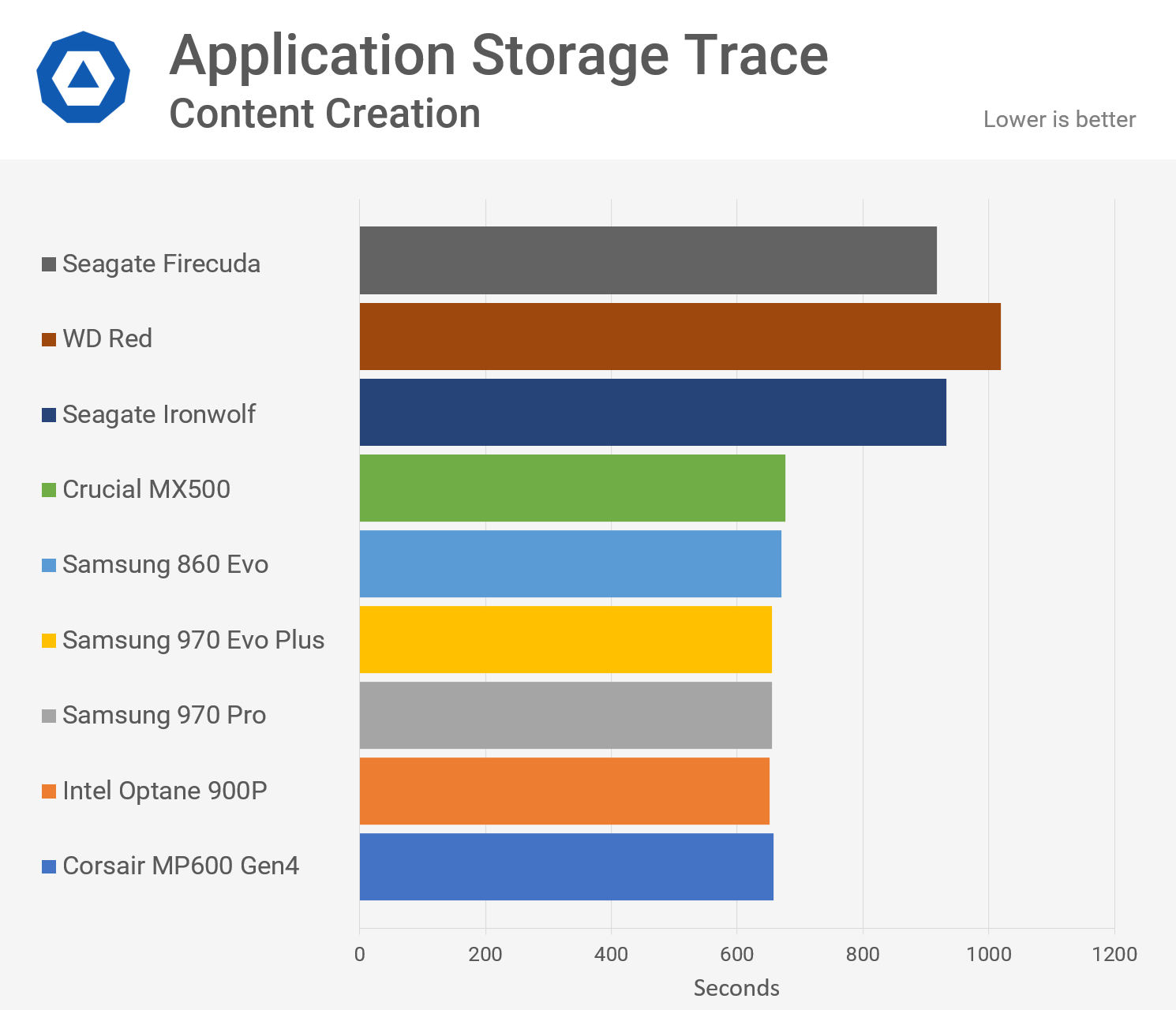
Among the mechanical drives, the Seagate Ironwolf is the clear winner since it is a 7200 RPM drive and the other two are 5400 RPM. The Seagate Firecuda performs well in content creation due to the addition of its 8GB NAND cache. A scratchpad for video scrubbing is the perfect application for a system like this. However, once we switch to gaming, the large texture files and randomized content can't take advantage of it.

For the SSDs, all drives are basically within a few percent of each other. The Optane drive wins in these tests, but by a very thin margin. In this scenario, the MX500 does almost as well as the Optane, a drive that costs ten times as much per GB. Looking at the rest of the SSDs, spending extra doesn't really get you a noticeable performance improvement. That being said, these three tests weren't very storage heavy to begin with, so we'll need to look at some other tests to a differentiation.

The next set of tests are game load times. I picked CS:GO as an eSports title that isn't particularly difficult to run and Shadow of the Tomb Raider since it is more of a cinematic game. The Tomb Raider test included a reboot in between runs, while the CS:GO test did not. There's nothing particularly good or bad about either testing methodology, I just chose one of each to represent different scenarios. In all three tests, the Corsair drive was the clear winner.

In the Tomb Raider tests, second and third were very close between the Optane and 970 Pro drives. Optane struggled a bit in the CS:GO launch since the drive isn't really designed for gaming, so that's not too surprising.

When launching the games, we see the mechanical drives not too far behind the SSDs since there isn't too much to load at the beginning. When you want to start up a level and enter the game though, the SSDs were two to three times faster. This is because the majority of the data that needs to be loaded when playing a game is texture and environment files.

We'll move over to the common task of file copying. We split the test into two: The first part is copying about 100 video files and the second is copying about 13,000 small files from a game installation. The large file test was just under 16GB while the small file test was 8.6GB. Both tests involved copying the files to another portion of the same disk. This allows us to test both reading and writing equally in the same operation.

The high sequential read and write speeds of the top four SSDs really shows in these tests. While the MX500 and 860 Evo were close to the others in previous tests, their limited SATA interface just can't keep up here.
These file tests were designed to fill up any temporary buffer that a drive may use to gain a temporary advantage. This is evident on the 860 Evo as it falls considerably behind the MX500. The Corsair MP600, with its new PCIe 4.0 interface, is the winner here, but not by much.
It's interesting to note that the mechanical drives all took roughly the same amount of time in both tests despite the large file test having almost twice the data to copy. We also see the gap between drives narrow in the small file test due to increased CPU overhead to process each new file handle and metadata.

The next test we'll look at is performance when running backup software. Everybody should be running at least some form of backup to protect themselves in case of an accident or malware, so this is a useful test. It measures the bandwidth of imaging the main boot partition of the drive and writing the result to another partition on the same drive. To account for slight differences in system size due to temporary files, bandwidth was calculated by dividing the resulting image size by completion time.
While you would expect this to be very storage heavy, it's not as simple as just copying everything from one location and putting it into another. Files must be processed and added to the resulting image file which takes some time. In this test, the 970 Pro is the winner followed closely by the MP600 and 970 Evo. We see that both the Seagate Firecuda and the 860 Evo are greatly hindered by their slower underlying storage. The backups in this test were roughly 90GB which is much larger than the few GBs of cache both drives have.

The last test we have to show today is the good old Windows 10 boot time. All systems were created from a fresh installation and all had the same programs and settings. This test was a tie between the MP600 and 970 Pro. The Optane 900p was about a half second behind and the 970 Evo was another second behind that. The Seagate Firecuda really struggled here compared to the competition with a terrible time of nearly 70 seconds.
What We Learned
Having covered a lot of different technology options, you should be better equipped to understand the pros and cons of spending on a fast and more expensive SSD as your main drive. You may also consider choosing a larger mainstream SSD or even a disk drive instead.
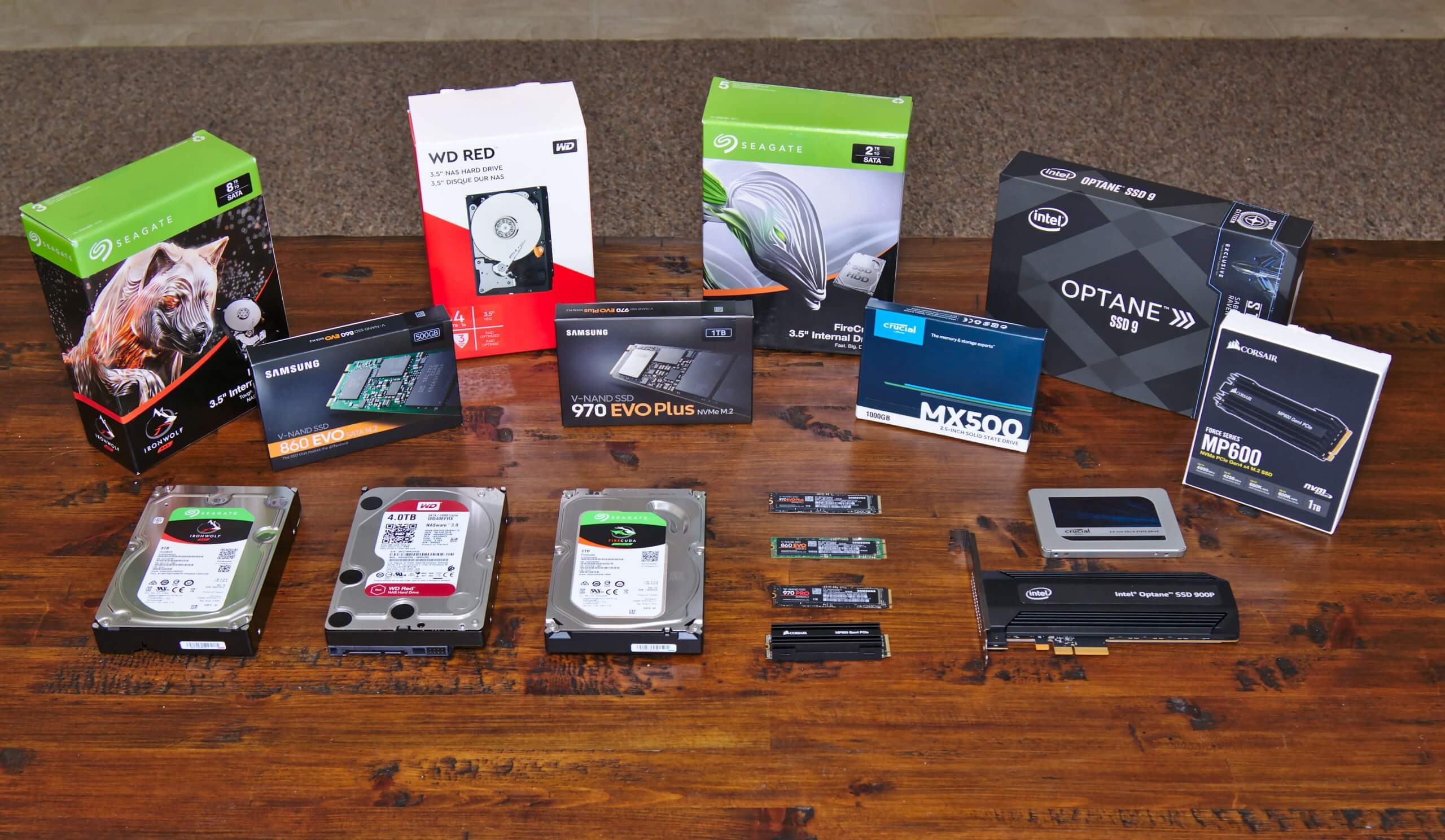
Overall, the Corsair MP600 Gen4 drive came up on top in this large set of consumer-level applications. PCIe 4.0 is a new interface (available only on AMD's latest platform for now) and that comes with some benefits, although we can't say it's overwhelmingly faster than the drives that came before it. What is most interesting is that Gen 4.0 drives are cheaper than almost everything else on the market that performs at those levels. Of all the Gen 4.0 drives we tested in our recent comparison, we liked the Sabrent Rocket best for its class leading performance and incredible price point. If you're retrofitting a new system that doesn't support PCIe Gen 4.0, you can still use the drives since they are backwards compatible.
If that's not an option for you, a mainstream Gen 3.0 drive like the Samsung 970 Evo Plus or WD Black are amazingly good choices, too. These drives offer solid performance at a significantly lower price than their top tier cousins.
If you're building a budget system for a friend or family member that doesn't do anything intensive, older SSD SATA drives are still a great choice. Inevitably, the prospect of spending about $100 for a terabyte of fast solid state storage, or a mere $58 for 500GB (Crucial MX500) makes us smile. They're noticeably faster than mechanical hard drives, but don't cost that much more.
We'd only recommend a mechanical hard drive as a media or backup drive since they're sluggish to use. The 5400 RPM drives were agonizingly slow to benchmark. We had to wait 20-30 minutes after booting up the system for the background tasks to finish up before we had an idle system. This would have taken just a few seconds on an SSD. This is also telling for those buying cheap laptops during the holidays; make sure whatever system you choose comes with decent solid storage.
Shopping Shortcuts:
"mechanical" - Google News
December 16, 2019 at 06:10PM
https://ift.tt/38Gvm7m
Storage Performance Roundup: Mechanical Disk Drives to PCIe 4.0 SSDs and Everything In Between - TechSpot
"mechanical" - Google News
https://ift.tt/36eZe8V
Shoes Man Tutorial
Pos News Update
Meme Update
Korean Entertainment News
Japan News Update
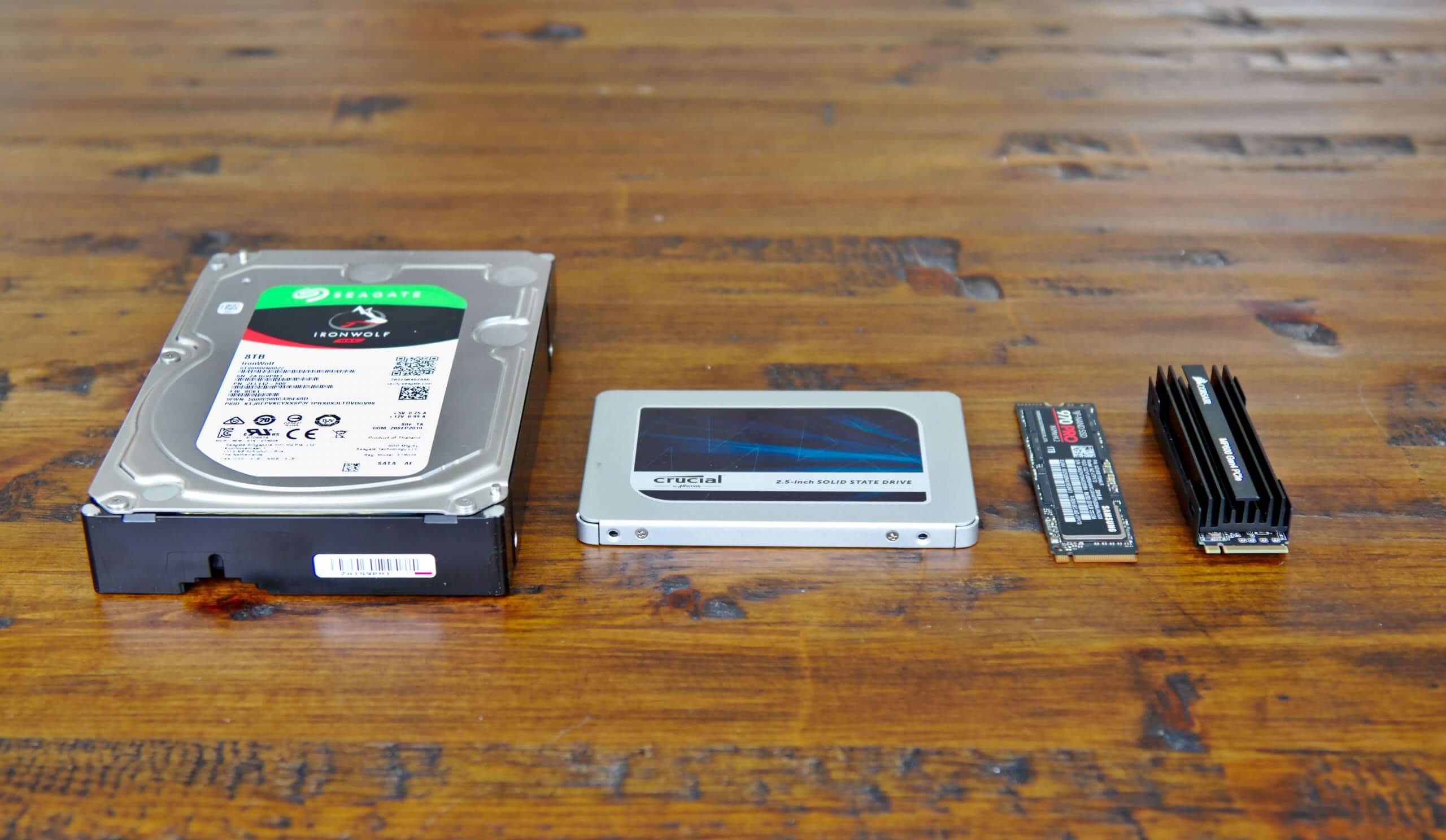
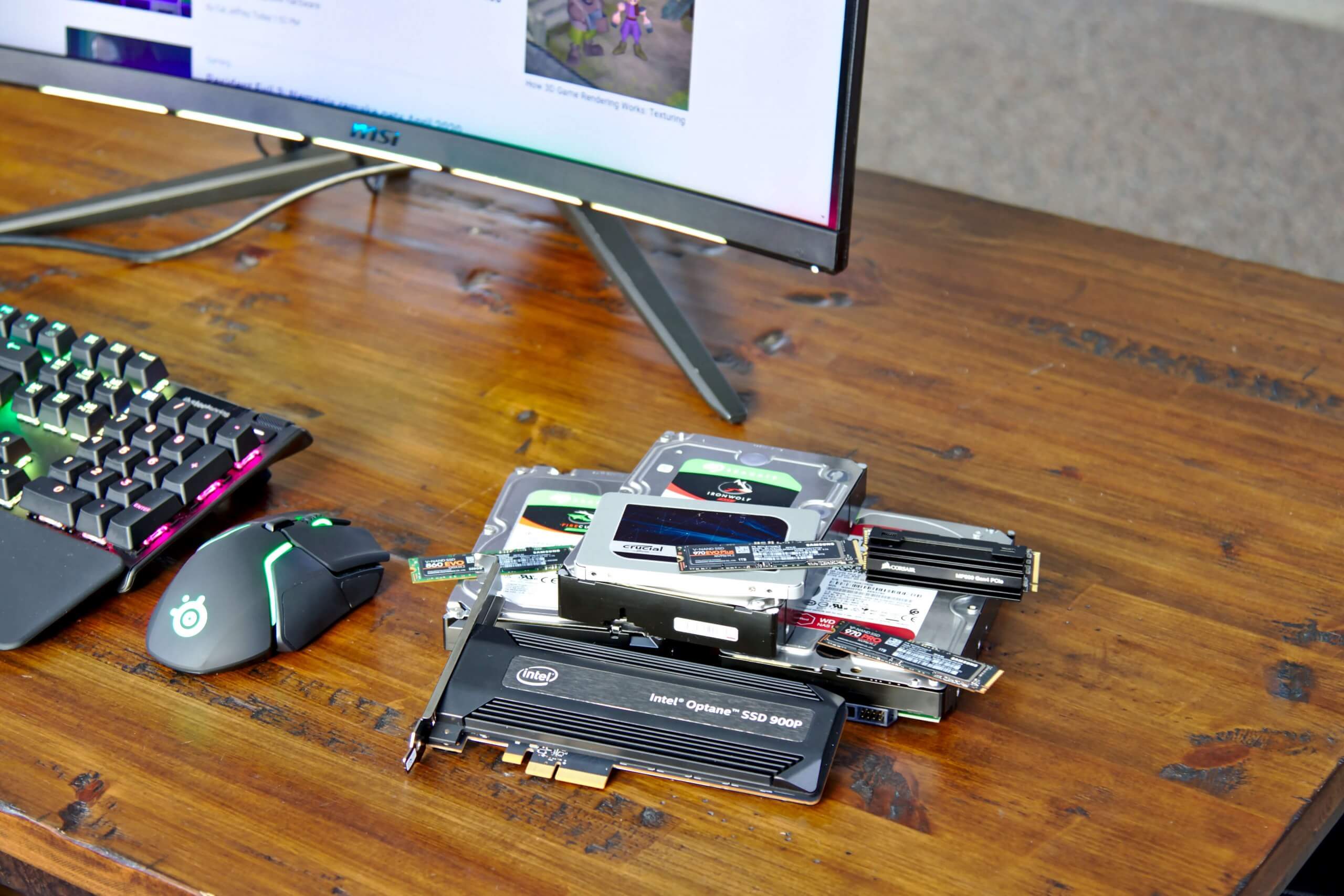
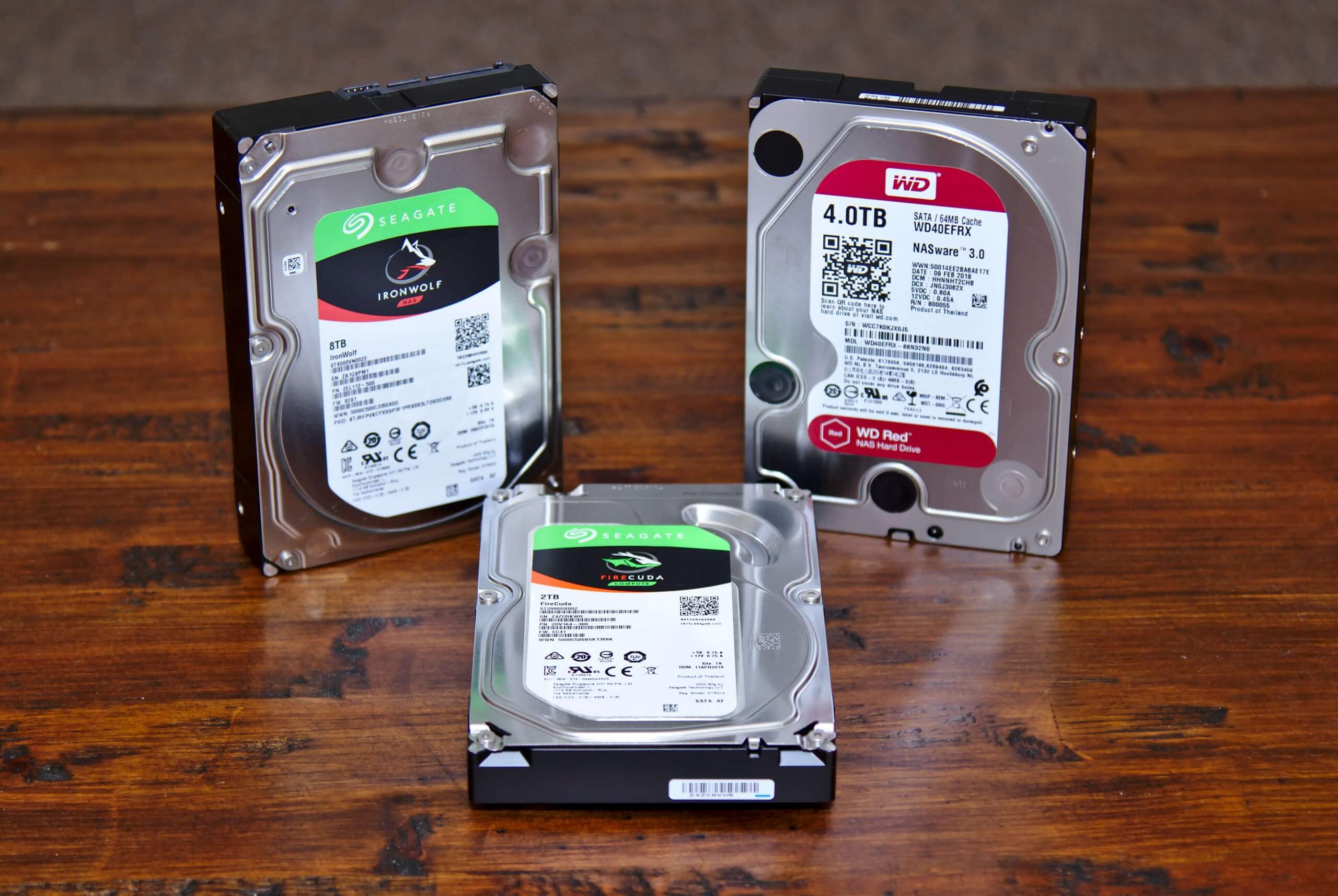
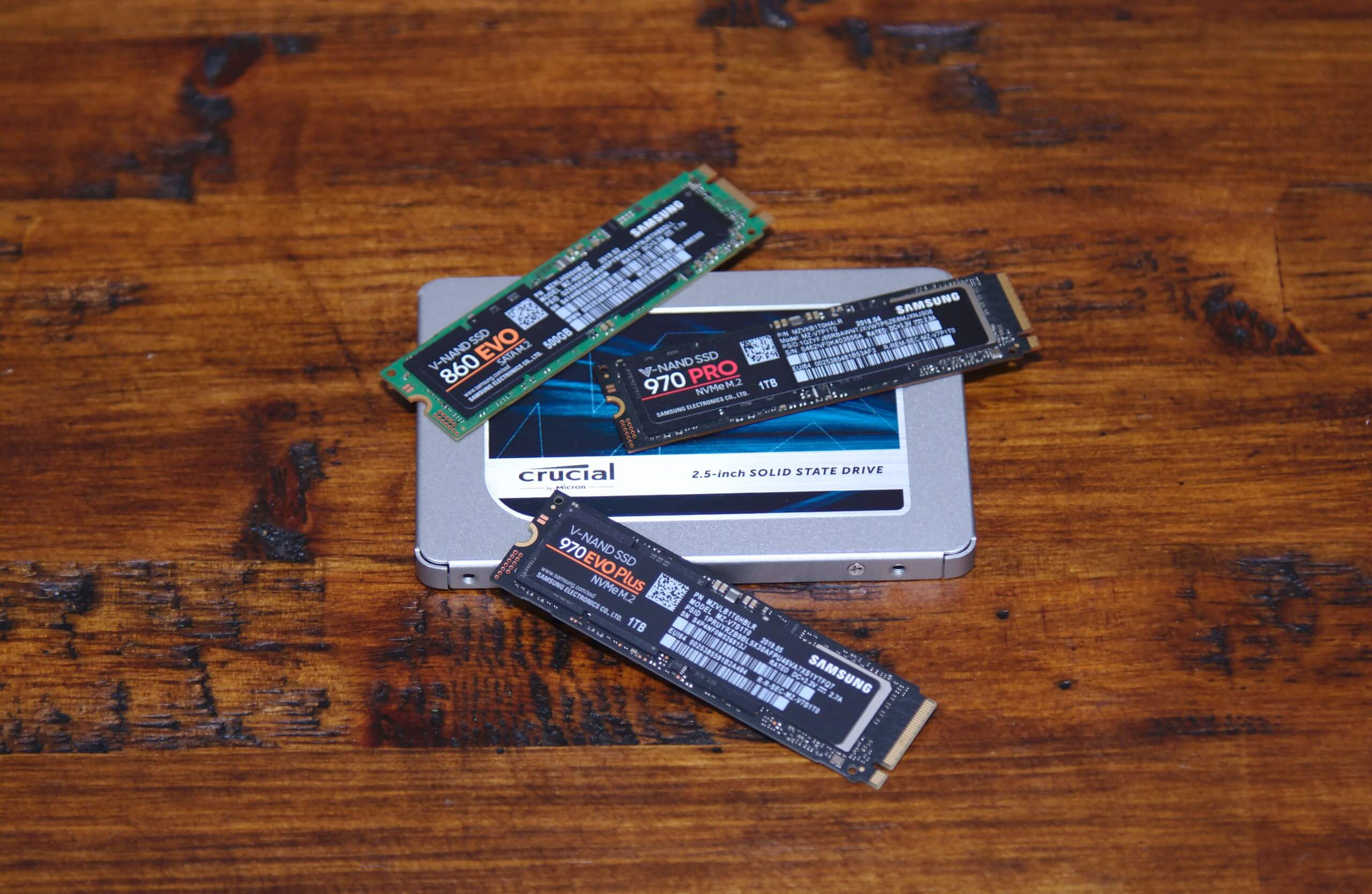



0 Comments:
Post a Comment